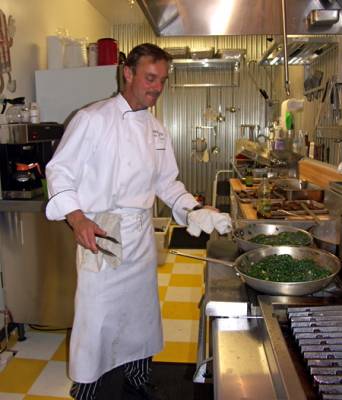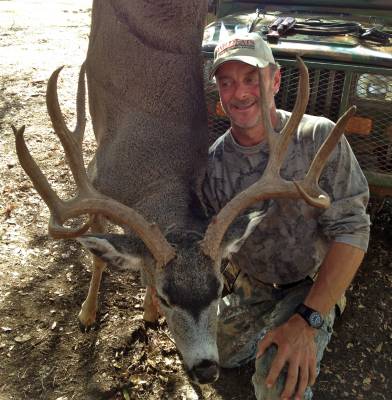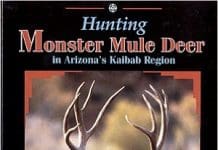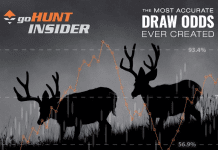In early 2008, I attended the Western Hunting & Conservation Expo in Salt Lake City, Utah. On the roster of speakers was a name I’d never seen but a topic I was highly interested in: cooking wild game. The speaker was John McGannon, a world class chef and hunter– not a likely combination. My wife, Jodi, and I attended the seminar. In one short hour, Chef McGannon forever changed the way I’ll prepare and cook wild game.

Chef John McGannon of Wildeats.com
In this blog post, I’ll introduce the Chef and and his company, WildEats Enterprises. He’ll also detail his proven method for producing tender, tasty wild game: Dry Aging. I guarantee if you’ll keep an open mind, he can improve your wild game eating experience. As proof, my wife was the typical I-don’t-like-deer-it’s-too-gamey-pass-the-chicken patron of my cooking. After following Chef McGannon’s techniques, I can now prepare venison that she’ll eat and enjoy. Our kids actually beg for it.
Chef McGannon graduated in 1982 from the The Culinary Institute of America in Hyde Park, New York and is widely recognized as one of the leading authorities on fine wild game cuisine. He has opened 13 restaurants in New York, Florida, Los Angeles, Hong Kong and San Francisco. It was here that his passion and attention to detail was developed for his company WildEats Enterprises.
Chef John McGannon is also a current columnist for these fine publications:
- RMEF BUGLE Magazine – Carnivore’s Kitchen…Eating Wild
- Mule Deer Foundation Magazine – Cuisine Elevation
- Outdoor News – Taste of the Wild
- Cooking Wild Magazine
He is also a noted speaker at the Rocky Mountain Elk Foundation Convention, Sacramento International Sportmen’s Expo, The Western Hunting and Conservation Convention, The Mule Deer Foundation Expo, and more. If you get the chance to attend a seminar, don’t miss it!
Take it away, Chef McGannon!
The WILDEATS DRY AGING TIME LINE
After a seminar I gave once on Dry Aging at the RMEF National Convention in Reno, I received many follow-up questions on the subject. Some of the more common questions were these:
1) “How long do I leave wild game to dry?”
2) “What size pieces of meat do I use?”
3) “How much time for Deer vs. Elk, etc?”
I designed a chart to answer these questions. As you can imagine, there are a bunch of variables when addressing those freezers full of paper-wrapped packages. Use this chart as a guideline, while applying common sense. This may be intimidating to some, but once you get the first batch down…and see the results you will become much more comfortable with the procedure. Just remember that all you are doing is drying out the meat, the only way to remove the gamey flavor of the blood (and no, slitting the throat won’t do the job.) Dry Aging also breaks down tough fibrous tissue making the meat much more tender.
There are many things that will effect the meat quality of an animal – age, health, habitat, shot placement, manner in which it was cooled, cross contamination issues, hunted during the rut (self inflicted adrenaline) and species of animal. And there are many issues that come into play when determining the amount of time needed to dry age a piece of game meat. The size of the piece of meat will determine the amount of time that you hang that meat. The larger the piece, i.e. quarters, the longer the hang time. The chart below is again a guideline, with the understanding that you may have to adjust the times to suit your specific situation.
If you plan on dry aging your meat after it has been in the freezer, leave those cuts as large as you can, WITH THE SILVER SKIN ATTACHED. This will give you the best yield after you finally age your meat and trim off all the darkened outer edges. There’s no sense trimming off the silver skin, then dry aging it and trimming off another layer of meat.
DRY AGING IS ALWAYS DONE UNDER REFRIGERATION
The temperature is crucial! Keep the meat above 33 degrees but below 40 degrees fahrenheit. Too cold, and the meat is in a frozen state and won’t age. Too warm, and spoilage occurs. Buy a meat thermometer from a cooking store that can measure those temps and make sure you meat stays in that range. Some clients have walk-in coolers to age meat. One client even modified an old fridge and can easily age a quartered deer or half of a quartered elk. It is acceptable to keep meat frozen until you have time/room to age it. Some butchers will age meat for you, some will not.
Let’s start with aging wild birds. Birds should be plucked and eviscerated with the internal cavity wiped clean. You can initiate drying from a fresh state as well as after it has defrosted from the freezer. These time lines start when the meat is completely defrosted. Dry Aging breasted out birds without any skin/bones to slow the drying process DO NOT APPLY to this time line. You can dry age those pieces of meat to a certain degree BUT since the meat will dry out too quickly, you will loose a great deal of meat in the process. This is a slow and gradual process. You get out what you put in. Breasting is a fast and easy way to avoid plucking and cleaning but like most shortcuts, it comes with a price. If you do have some breasts, try placing a dry (lint-free) towel over the meat. This will slow the evaporation process down a bit and extend the time you can dry out those tough fibrous tissues.
UPLAND BIRDS
Quail 1 day
Chukar/Partridge 2 days
Grouse 2-3 days
Pheasant 2-3 days
Wild Turkey 3-4 days
These are recommended times for whole birds with the skin attached. The skin plays a vital role in slowing down the evaporation process. If the meat dries out too fast then you aren’t accomplishing your goal of breaking down the fiber structure. You see those little tough fibers need time to breakdown as they are drying.
Planted birds require a little less time, as their muscle structure isn’t so developed.
RED MEAT BIRDS
Doves 1 day
Band-tailed pigeons 1-2 days
Teal (sm. ducks) 1-2 days
Widgeon (med. ducks) 2-4 days
Sprig/Mallards (lg. ducks) 4-7 days
Specks/Snow Geese 7-10 days
Honkers* 10-14 days
* Aging these very tough birds for this long will give you an incredible tender result. Once aged bone-out the breasts and treat as though they were a tender steak. Cook quickly and rare. Save the legs for chili, stew or sausage. You won’t believe how tender they can be if you have the patience! Always slice across the grain.
LARGE GAME ANIMALS:
Elk, Moose (quarters) 14 days
Elk, Moose (muscle groups, i.e. top sirloin) 7-10 days
Deer, Caribou, Sheep, Antelope (quarters) 10 days
Deer, Caribou, Sheep, Antelope (muscle groups) 7-10 days
Wild Boar (quarters) 8 days
Wild Boar (muscle groups) 4-8 days
Bear** 4-8 days
If you have your meat already cut into steaks, the same approach applies as with the breasted birds. The meat will dry out too quickly. If you have no choice at this point you can dry age your steaks for a day or two and it will help. It just won’t have the chance to get to its full potential. You’ll know better next time.
** Dealing with bear meat can be a little tricky. If the bear is consuming garbage as a source of its diet it could be subject to parasites, viruses and microorganisms that can be harmful to human consumption. Please be careful when dealing with bear meat. I would recommend cooking bear meat thoroughly (above 165° F) before eating. This isn’t always the case but its better to be safe than sorry.
-Chef McGannon

Thanks John! If you have any questions for Chef McGannon, or would like to try his fine line of wild game dry rub and seasonings, visit his webiste at www.wildeats.com
You can also follow his very interesting Facebook here
Don’t forget to subscribe to the Rok Blog (top right of blog under Fitness/Other) so you don’t miss upcoming information that can make you a better hunter.




















This is one of the better posts Robby! Will he be back for a round two? Thanks for the info!
Thanks! I’d imagine if Chef McGannon gets a little prompting in this comments section, he’ll be back. I happen to know he has a great method for getting the most out of frozen meat and has a spice compass that can make us all better cooks.
I’ve been using Johns dry rubs on my pheasant and waterfowl for a few years now and absolutely love it. Its all you need to make a quick and delicious meal of a bird. I see him every year at Sportsman Expo in Sacramento, CA. This time I’ll have to try some of his other seasonings.
Comments are closed.